-
Welcome to BirdForum, the internet's largest birding community with thousands of members from all over the world. The forums are dedicated to wild birds, birding, binoculars and equipment and all that goes with it.
Please register for an account to take part in the discussions in the forum, post your pictures in the gallery and more.
botswana
-

ID help needed weaver Botswana, Africa
This was taken at Elephants Sands Lodge, Central District Botswana. June 2018. I would appreciate some help in cleaning up some unidentified birds. please! Thanks in anticipation.- Stephen Powell
- Thread
- botswana nest weaver bird
- Replies: 1
- Forum: Bird Identification Q&A
-

Lesser Swamp Warbler
Sometimes called "Cape Reed Warbler" members of the genus "Acrocephalus" are notoriously tricky to identify. We originally misidentified this bird as a Greater Swamp Warbler but I sent the photos to various experts who were unanimous in their opinions that it was a Lesser. Greater has a rather...- jmorlan
- Media item
- acrocephalus gracilirostris botswana lesser swamp warbler
- Comments: 2
- Category: Africa
-

Nile Monitor (Varanus niloticus)
Sometimes called "African small-grain lizard," this large semiaquatic lizard has been introduced into parts of Florida where it is considered an invasive pest. In their native Africa, some of the subpopulations have been recognized as potential species, but more research is needed. Their diet is...- jmorlan
- Media item
- botswana nile monitor varanus niloticus
- Comments: 3
- Category: Reptiles
-

Meves's Starling
Sometimes called "Meves's Glossy Starling." A rather large, iridescent glossy starling with a very long and graduated tail. They usually have blue and purple iridescence but this one shows a lot of bronze on its belly. Compare with Burchell's Starling which has a shorter tail and longer wings...- jmorlan
- Media item
- botswana lamprotornis mevesii meves's starling
- Comments: 3
- Category: Africa
-

Coppery-tailed Coucal
These large short-legged, huge prehistoric-looking members of the cuckoo family like to spread their feathers while sunning as seen here. They are rather shy and we only saw this species once. With its long tail it reminds me of a pheasant. They are weak flyers and clambers around in trees and...- jmorlan
- Media item
- botswana centropus cupreicaudus coppery-tailed coucal
- Comments: 5
- Category: Africa
-

African Barred Owlet
A member of the bar-fronted group, this is "G. c. ngamiense" characterized by small size, brown head with small white bars (not spots), and facial disc with broad white bars. A recent study suggested that this group may be a distinct species based on morphology, geographical distribution...- jmorlan
- Media item
- botswana glaucidium capense
- Comments: 2
- Category: Africa
-

Yellow-billed Oxpecker
Of the two species of Oxpecker, this was much less common than the Red-billed. We only saw three Yellow-billed vs. 20 of the Red-billed. Although still classified as "least concern" by IUCN, I understand that this species has declined because of arachnivides used on cattle to control ticks and...- jmorlan
- Media item
- botswana buphagus africanus yellow-billed oxpecker
- Comments: 3
- Category: Africa
-

Water Thick-knee
This species is more closely associated with water than other thick-knees and also more active during the day. Its streaked gray wing panel distinguishes it from the more widespread Spotted Thick-knee (B. capensis). Thick-knees are in their own family, the Burhinidae. They are rather large...- jmorlan
- Media item
- botswana burhinus vermiculatus water thick-knee
- Comments: 1
- Category: Africa
-

Squacco Heron
Hiding in the reeds, this small compact heron reminds me of a heavily pigmented Cattle Egret. When they fly they transform into a mostly white bird with all white wings and belly. They are resident in Africa, but migratory in southern Europe and Asia.- jmorlan
- Media item
- ardeola ralloides botswana squacco heron
- Comments: 3
- Category: Africa
-

African Sacred Ibis
Historically, this species was abundant in Egypt, where millions were mummified as offerings to the god Thoth. By the end of the 19th century they had completely disappeared from Egypt. This is an adult with unfeathered all black head and neck. Formerly lumped with the Black-headed Ibis ("T...- jmorlan
- Media item
- african sacred ibis botswana threskiornis aethiopicus
- Comments: 1
- Category: Africa
-

Pel's Fishing-Owl
One of these iconic fishing owls was on the grounds of the lodge, but the local guide was unable to locate it for us. So he took us on a rather long boat ride to another stake-out which was successful. This is a large, round-headed, ginger colored owl saturated with dusky markings. They are...- jmorlan
- Media item
- botswana pel's fishing-owl scotopelia peli
- Comments: 6
- Category: Africa
-

Long-crested Eagle
The spectacular crest often blows in the breeze. Seemingly all dark when perched, large white patches appear in the wings when in flight. This unique bird is the only member of the genus "Lophaetus." Some authors place this species in the genus "Spizaetus," a name now reserved for a group of...- jmorlan
- Media item
- botswana long-crested eagle lophaetus occipitalis
- Comments: 1
- Category: Africa
-

Hamerkop
The worn tips to the wing coverts suggest that this is an adult. Endemic to sub-Saharan Africa, this species is the sole member of the family Scopidae. It appears to be related to the herons, but has odd features suggesting affinities with storks, flamingoes and even plovers. It is said to build...- jmorlan
- Media item
- botswana hamerkop scopus umbretta
- Comments: 2
- Category: Africa
-

African Stonechat
This is a male. The former Stonechat (Saxicola torquatus) has been split into three species, European Stonechat (Saxicola rubicola), Siberian Stonechat (Saxicola maurus), and African Stonechat (Saxicola torquatus), based on a series of phylogenetic analyses of DNA sequence data. Within the...- jmorlan
- Media item
- african stonechat botswana saxicola torquatus
- Comments: 4
- Category: Africa
-

African Skimmer
Skimmers are in their own family, the Rynchopidae characterized by their lower mandible being noticeably longer than the upper and having the upper mandible attached to the skull by a hinge. They are largely nocturnal and have "cat's eyes" in which the pupil closes into a slit; unique among...- jmorlan
- Media item
- african skimmer botswana rynchops flavirostris
- Comments: 3
- Category: Africa
-

African Fish-Eagle
An iconic, distinctive, chestnut-and-white eagle sitting majestically on a perch along the river. They were fairly common here in the Okavango. This is an adult. As in many raptors, females are larger than males.- jmorlan
- Media item
- african fish-eagle botswana haliaeetus vocifer
- Comments: 4
- Category: Africa
-
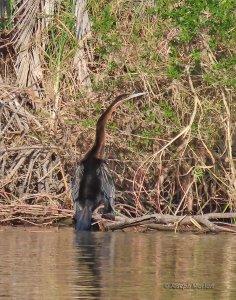
African Darter
Darters tend to swim with their whole body underwater, often exposing their snake-like neck, thus the name "Snakebird." This is the nominate race which ranges south of the Sahara.- jmorlan
- Media item
- african darter anhinga rufa botswana
- Comments: 2
- Category: Africa
-
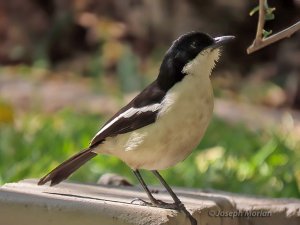
Gabon Boubou
Not a true shrike, but a member of the Bush-shrike family. This is the race "Laniarius bicolor sticturus" sometimes called the Okavango Boubou. It is characterized by having white on outer edges of innermost three secondaries forming a long white wing-stripe. In Southern Africa this species...- jmorlan
- Media item
- botswana gabon boubou laniarius bicolor
- Comments: 1
- Category: Africa
-
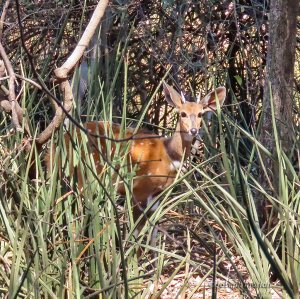
Southern Bushbuck (Tragelaphus sylvaticus)
Proposed as a separate species this race is often called Chobe Bushbuck (T. s. ornatus). Sometimes called "Cape Bushbuck," they are said to be the smallest of the spiral-horned antelope. They are largely nocturnal making them particularly difficult to see. This is a male. Females lack the short...- jmorlan
- Media item
- botswana southern bushbuck tragelaphus sylvaticus
- Comments: 0
- Category: Wild Mammals
-
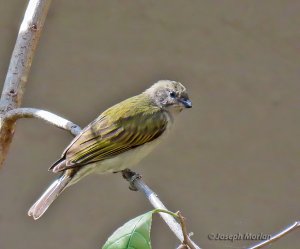
Lesser Honeyguide
Called Honeyguides because their calls leads mammals to the hives of honeybees, but Lesser Honeyguide is an exception. It does not lead predators to bees, but instead eats the honey, honeycombs and beeswax itself. This species is also a notorious brood parasite, laying its eggs in the nests of...- jmorlan
- Media item
- botswana indicator minor lesser honeyguide
- Comments: 0
- Category: Africa
-
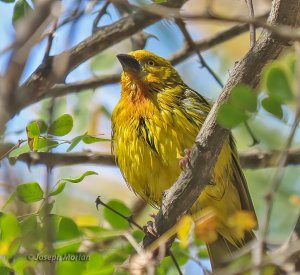
Holub's Golden-Weaver
Wet from bathing, this weaver may be identified from similar species by its large size, heavy black bill and pale eyes. The orange color on its throat suggests this one is an adult male.- jmorlan
- Media item
- botswana holub's golden-weaver ploceus xanthops
- Comments: 1
- Category: Africa
-
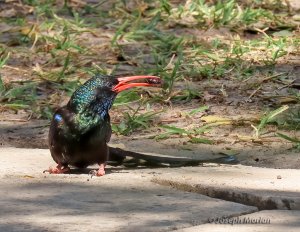
Green Woodhoopoe
They usually forage in trees, but this one was picking between the path flagstones at our lodge. They are astonishing looking, long tailed birds with flickering iridescent plumage that varies with the light. Woodhoopoes are in their own family, the Phoeniculidae. This is an adult. Immatures...- jmorlan
- Media item
- botswana green woodhoopoe phoeniculus purpureus
- Comments: 2
- Category: Africa
-
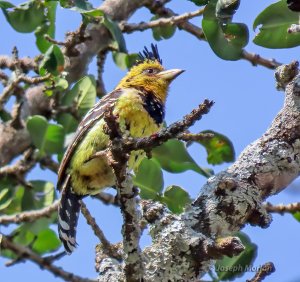
Crested Barbet
An adult based on its pale bill and likely a female by its muted red colors. A distinctive fairly common forest species which appears to be expanding its range Of the two subspecies, this one is the slightly larger and darker nominate "T. v. vaillantii."- jmorlan
- Media item
- botswana trachyphonus vaillantii
- Comments: 1
- Category: Africa
-
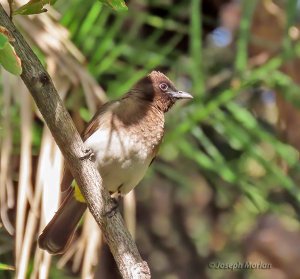
Common Bulbul
Distinguished from the similar Black-fronted Bulbul by its brown, not red eyes. Both species overlap in this area. This species is sometimes called "Black-eyed Bulbul" and they can become habituated to humans and reportedly steal food from safari lodge dining areas. This is the dark subspecies...- jmorlan
- Media item
- botswana common bulbul
- Comments: 0
- Category: Africa
-
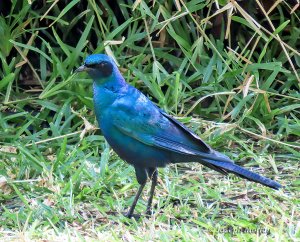
Burchell's Starling
Formerly called Burchell's Glossy-Starling or Greater Glossy Starling. It differs from Cape Starling by Burchell's longer tail, dark eye and black mask. Like many similar species, the light must hit just right to reveal the iridescent colors.- jmorlan
- Media item
- botswana burchell's starling lamprotornis australis
- Comments: 0
- Category: Africa



